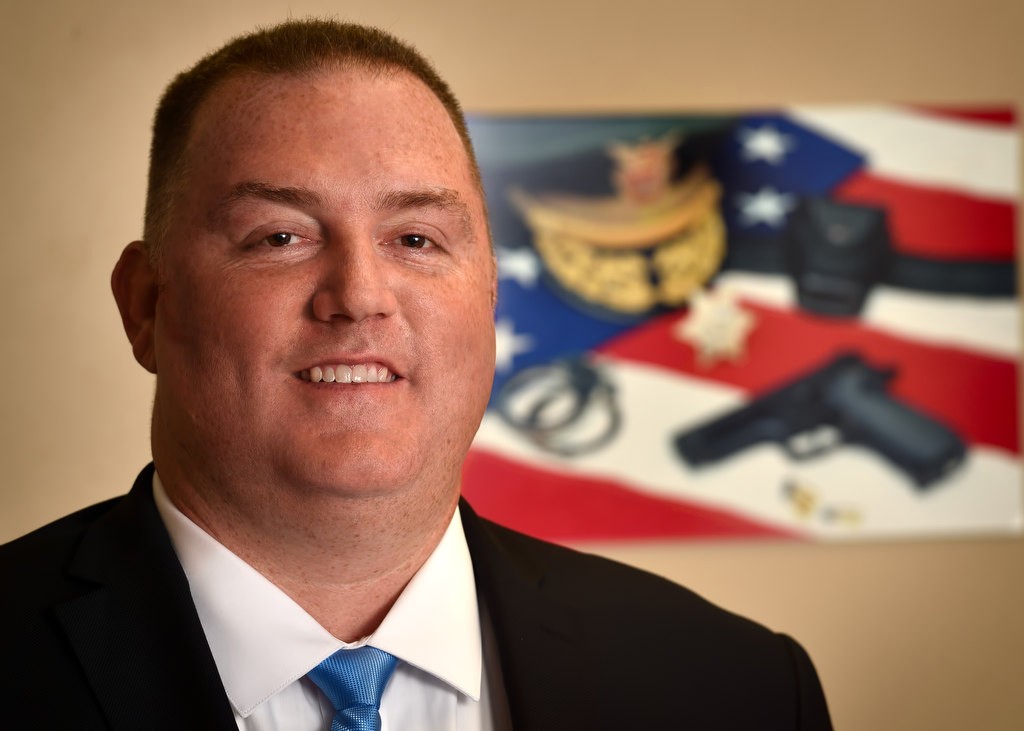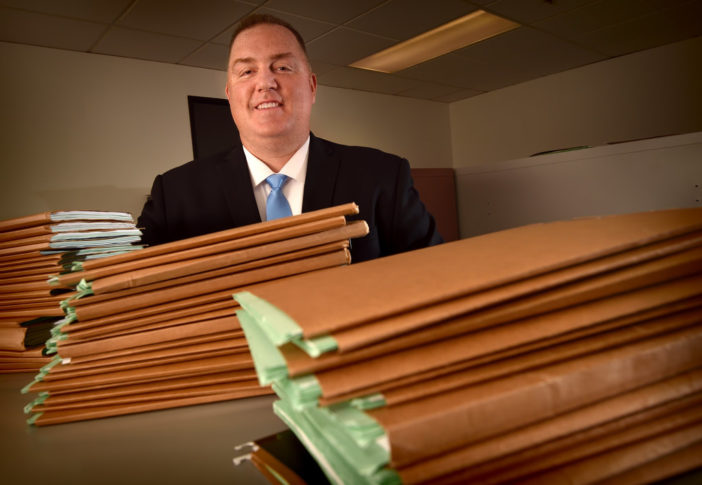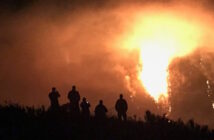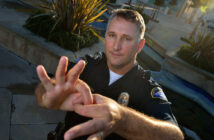In a cramped room on the fourth floor of Santa Ana’s Brad Gates Building, which houses the Orange County Sheriff’s Department’s Support Services Division, several cabinets are jammed with files, with overflow files stacked atop the cabinets.
The mounds of paperwork aren’t cold-case files, or other criminal documents.
They are applications past and current for Carry a Concealed Weapon permits (CCWs) — reams of documents that are required whenever Joe or Jane Citizen seeks legal permission to pack heat.
A little more than 2½ years ago, there only were about 800 active CCW permits in Orange County, with two professional staff members handling the application process.
Now there are more than 9,300 active CCW permits in O.C. — an avalanche-like surge in demand that has forced the creation of an entire department within the OCSD, the Carry a Concealed Weapon (CCW) Licensing Unit, which employs more than two-dozen sworn and professional staff.
Applicants for CCWs run the gamut, from students to owners of Fortune 500 businesses to plumbers, lawyers and elected officials.
A number of reasons are behind the explosion in demand for CCWs, including a landmark 2014 court ruling, increased awareness among the general public about the process involved in obtaining a CCW license, and recent mass-shootings and terrorist events that have compelled citizens to arm themselves for self-protection.
Faced with the dramatic spike in demand for CCWs, the OCSD says it’s doing its best to expedite the process of moving applications through the system as quickly as possible, without compromising the level of scrutiny of each applicant.
“There’s been a lot of misinformation out there,” says Lt. Matthew Stiverson of the OCSD’s Professional Standards Division.
Stiverson says there have been gripes, mostly on social media, that it has become tougher than ever to get a CCW in Orange County — and that the system is loaded with unnecessary lengthy delays.
In reality, Stiverson says, the OCSD wasn’t prepared for a surge in CCW applications that followed the February 2014 court ruling, Peruta v. County of San Diego. The agency was forced to play catch up and furiously add staff as mountains of applications translated to waits for an initial appointment of up to a year.
Now, Stiverson says, the OCSD — after staffing up and relocating the CCW Licensing Unit to larger offices — usually is able to see an applicant for his or her initial CCW appointment within two to six months depending on fluctuations in public demand and unit staffing levels. The agency’s target goal is to reduce initial appointment wait times to less than two months.

OCSD’s Lt. Matthew Stiverson: “We’re trying to get everyone scheduled and brought in as quickly as possible.”
Photo by Steven Georges/Behind the Badge OC
“We’re trying to get everyone scheduled and brought in as quickly as possible,” Stiverson says. “We rapidly expanded as quickly as possible to address the needs of citizens.”
LANDMARK COURT RULING
State law puts sheriff’s agencies in charge of issuing CCWs to residents in their jurisdictions.
For years, in addition to passing a background check, applicants had to articulate a “good cause” beyond more than “self-defense” or “personal protection” to be considered for a CCW permit.
That requirement changed in February 2014, when a federal three-judge panel held in Peruta that the “good cause” requirement violated the Second Amendment right to keep and bear arms.
That change in state law triggered a flood of CCW applications into the OCSD and sheriff’s agencies throughout the state.
But in June 2016, the “good cause” requirement was reinstated after the 9th U.S. Circuit Court of Appeals voted to rehear “en banc” the Peruta case and, in a 7-4 ruling, upheld the authority of sheriff’s agencies to require applicants to articulate their safety concerns beyond “self-defense” or “personal protection.”
CCW licenses issued under the previous Peruta standard were not recalled, but supplemental “good cause” language was required for those seeking to renew their CCW licenses, which for most applicants are valid for two years (for judges it’s three years and for reserve peace officers it’s four).
Since taking office in 2008, Sheriff Sandra Hutchens has said she’s been committed to providing the public with an efficient CCW application process.
And that hasn’t changed, Hutchens says.
“I have remained consistent in my approach to CCWs — I follow the law,” Sheriff Hutchens says. “I will always uphold the decisions of the court, and ensure that our department thoroughly vets all CCW applicants. If a citizen believes that a CCW is the best tool for their personal safety and they have good cause, I invite them to apply.”
There currently are more than 2,500 O.C. citizens in the CCW application process, with a team of four deputies devoted full time to driving around O.C. to confirm the residency requirement — one of four main key requirements, along with the “good cause” statement, having good moral character, and being trained in the use of firearms.
Applicants also must be at least 21 years old.
BUSY OFFICE
On a recent weekday morning, the OCSD’s Carry a Concealed Weapon Licensing Unit was buzzing with activity.
A handful of applicants were waiting in a fourth-floor lobby for their initial interview.
In the back offices, several OCSD officials were interviewing applicants, making sure their paperwork was in order and confirming the information on the forms.
Prior to getting an appointment for a CCW license, applicants first had to request one online and bring in with them a state Department of Justice, Bureau of Firearms application.
And they had to provide a Good Cause statement as part of OCSD Policy 218.
Examples of “good cause” may include evidence that there has been or is likely to be an attempt on the part of a second party to do great bodily harm to the applicant; the nature of the business or occupation of the applicant is such that it is subject to high personal risk and/or criminal attack, far greater risk than the general population; and, a task of the business or occupation of the applicant requires frequent transportation of large sums of money or other valuables and alternative protective measures or security cannot be employed.
“We don’t rubber-stamp deny people who have a vague good-cause statement,” Stiverson notes. “We will probe deeper and ask more questions.”
In adding to fingerprinting, background checks, an interview, successful completion of firearms training and fees that total around $300 to $400, applicants also may be required to pass a psychological examination.
If an applicant has a criminal history, a propensity toward violence or poor decision-making issues, the OCSD can refer applicants to a psychological evaluation. Some are randomly chosen for such an evaluation; others, such as those who, for example, say they were treated for mental illness as a teenager, will undergo a psychological exam.
According to Stiverson, only about 4 percent of CCW applications in O.C. are denied. Most are denied either because the applicant decides not to complete the process or for disqualifying requirements, like a previous felony conviction.
He said the OCSD continues to fine tune its CCW application process.
“We have begun to add additional staff and we are planning to implement a new software program later this year that will help streamline the process by improving efficiencies in several areas,” says Stiverson, an OCSD veteran of 20 years who began overseeing the CCW unit 2½ years ago.
“These system improvements will significantly reduce scheduling wait times and processing turnaround times for new applicants and current licensees.”
Stiverson says much of the delay in the CCW process is applicant driven; for example, not having all the required supporting documents will slow the process down.
He doesn’t see the flood of applications slowing in the foreseeable future.
“Based on the number of applications pending and the CCWs already issued, we anticipate passing the 20,000 mark,” Stiverson says. “The demand is absolutely out there.”
 Behind the Badge
Behind the Badge



